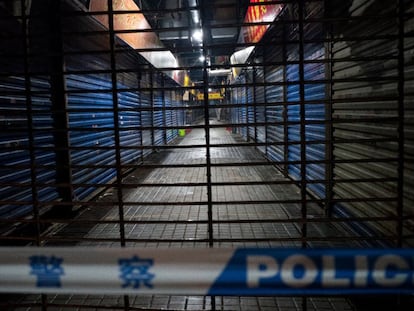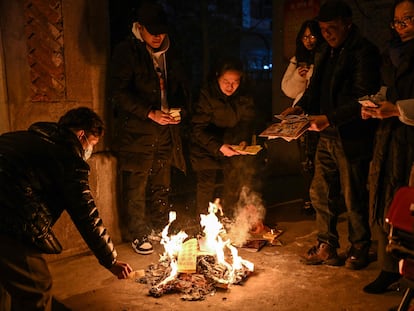Natural contagion or laboratory accident? US intelligence declassifies Covid-19 origins report
US intelligence is divided between the two hypotheses but have ruled out the virus being created as a biological weapon


U.S. intelligence services on Friday declassified a report on the potential links between the Wuhan Institute of Virology (WIV) and the origin of the Covid-19 pandemic. Although some excerpts remain censored, the report points to two alternative hypotheses and is inconclusive. Some U.S. agencies believe SARS-CoV-2, the novel coronavirus that causes Covid, evolved in nature while others suspect it was developed in a laboratory.
The report was issued in compliance with a law approved by the U.S. Congress and signed by President Joe Biden last March, which obliged the government to produce the information available to the intelligence services on the possible links between the WIV and the origin of the coronavirus pandemic within 90 days.
The report, conducted by the Office of the Director of National Intelligence, warns at the outset that it does not weigh up the merits of the two most likely pandemic origins hypotheses, nor does it provide information about other biological facilities in Wuhan, where the first cases were detected, beyond the WIV.
Former president Donald Trump, frequently used the origin of the virus as a dialectical weapon of confrontation with China, something Biden has avoided at a time of heightened tension between the two superpowers.
In March, the U.S. intelligence community updated its analysis of the major questions surrounding the origins of Covid-19 to address whether the first human infection with SARS-CoV-2 was the result of natural exposure to an infected animal, or a laboratory-associated incident. " All agencies continue to assess that both a natural and laboratory-associated origin remain plausible hypotheses to explain the first human infection,” states the report.
The National Intelligence Council and four other intelligence agencies estimate that the initial human infection was most likely caused by natural exposure to an infected animal carrying SARS-CoV-2 or a close progenitor - a virus that would likely be more than 99% similar to SARS-CoV-2.
In contrast, the Department of Energy and the Federal Bureau of Investigation (FBI) believe that a laboratory-associated incident was the most likely cause of the first human SARS-CoV-2 infection, albeit for different reasons.
The Central Intelligence Agency (CIA) and another agency remain undecided as to the exact origin of the Covid-19 pandemic, believing that both hypotheses are based on significant assumptions or face issues with conflicting reports.
What “almost all” agencies agree on is that SARS-CoV-2 was not genetically engineered. Most of the agencies believe that it was not laboratory-adapted, although some say they cannot reach a conclusion. However, all agencies believe that SARS-CoV-2 was not developed as a biological weapon.
Detailing the information available on the Wuhan Institute of Virology, the report notes that intelligence agencies believe that, prior to the pandemic, its scientists were conducting extensive coronavirus research, including animal sampling and genetic analysis. “We continue to have no indication that the WIV’s pre-pandemic research holdings included SARSCoV-2 or a close progenitor, nor any direct evidence that a specific research-related incident occurred involving WIV personnel before the pandemic that could have caused the Covid pandemic,” the report says.
The United States has concluded that some WIV scientists genetically manipulated coronaviruses using common laboratory practices. However, it has no information indicating that any genetic engineering work at the Institute involved SARS-CoV-2, a close progenitor, or a backbone virus that is sufficiently related to have been the source of the pandemic.
The report adds that WIV scientists created genetically engineered chimeras, or combinations, of SARS-type coronaviruses, attempted to clone other unrelated infectious viruses, and used reverse gene cloning techniques on SARS-like coronaviruses. It also states that some of the genetic engineering projects on coronaviruses involved techniques that could make it difficult to detect intentional changes. A 2017 dissertation by a WIV student showed that reverse gene cloning techniques, standard techniques used in advanced molecular laboratories, left no traces of genetic modification of SARS-like coronaviruses, the report notes.
Risk of accident
The possibility of an accident is still very much present in the report. Although there is no record of any specific biosafety incident that led to the pandemic, “Some WIV researchers probably did not use adequate biosafety precautions at least some of the time prior to the pandemic in handling SARS-like coronaviruses, increasing the risk of accidental exposure to viruses,” it says.
The report also addresses another sensitive issue, but without shedding much light on it. Several WIV researchers fell ill in the fall of 2019, with some of their symptoms consistent with Covid-19, although they were not diagnosed with the disease. “The intelligence community continues to assess that this information neither supports nor refutes either hypothesis of the pandemic’s origins because the researchers’ symptoms could have been caused by a number of diseases and some of the symptoms were not consistent with Covid-19″, the report said.
U.S. intelligence has no indication that any of those researchers were hospitalized due to symptoms consistent with Covid. It is possible that one of the investigators was hospitalized during this period for treatment of a non-respiratory medical condition, the report notes.
Chinese authorities investigated the WIV in early 2020 and took blood samples from the scientists. The U.S. notes that, according to the World Health Organization’s March 2021 public report, WIV employees, including Shi Zhengli, who heads the laboratory group conducting the coronavirus investigation, stated that all laboratory employee samples tested negative for antibodies to SARS-CoV-2.
Although several investigators fell mildly ill in the fall of 2019, they experienced a range of symptoms consistent with colds or allergies with accompanying symptoms typically not associated with Covid, and some were confirmed to have had other illnesses, the text adds. “While some of these researchers had historically conducted research into animal respiratory viruses, we are unable to confirm if any of them handled live viruses in the work they performed prior to falling ill,” the text concludes. The bottom line is that, for the time being, there remains no definitive conclusion.
Sign up for our weekly newsletter to get more English-language news coverage from EL PAÍS USA Edition
Tu suscripción se está usando en otro dispositivo
¿Quieres añadir otro usuario a tu suscripción?
Si continúas leyendo en este dispositivo, no se podrá leer en el otro.
FlechaTu suscripción se está usando en otro dispositivo y solo puedes acceder a EL PAÍS desde un dispositivo a la vez.
Si quieres compartir tu cuenta, cambia tu suscripción a la modalidad Premium, así podrás añadir otro usuario. Cada uno accederá con su propia cuenta de email, lo que os permitirá personalizar vuestra experiencia en EL PAÍS.
¿Tienes una suscripción de empresa? Accede aquí para contratar más cuentas.
En el caso de no saber quién está usando tu cuenta, te recomendamos cambiar tu contraseña aquí.
Si decides continuar compartiendo tu cuenta, este mensaje se mostrará en tu dispositivo y en el de la otra persona que está usando tu cuenta de forma indefinida, afectando a tu experiencia de lectura. Puedes consultar aquí los términos y condiciones de la suscripción digital.
More information
Archived In
Últimas noticias
There is as much life left to discover on planet Earth as that which is already known
Dozens presumed dead, around 100 injured in fire at Swiss Alps bar during New Year’s celebration
Is porn for women different from conventional porn? We spoke to those who make it
Cartagena de Indias is sinking: What can the city do to mitigate it?
Most viewed
- Reinhard Genzel, Nobel laureate in physics: ‘One-minute videos will never give you the truth’
- David King, chemist: ‘There are scientists studying how to cool the planet; nobody should stop these experiments from happening’
- Oona Chaplin: ‘I told James Cameron that I was living in a treehouse and starting a permaculture project with a friend’
- Sinaloa Cartel war is taking its toll on Los Chapitos
- The Interoceanic Train, the Mexican alternative to the Panama Canal










































